译林3下Unit1第三课时教案
三年级下册英语教学设计Unit 1 In class 第1课时 译林版
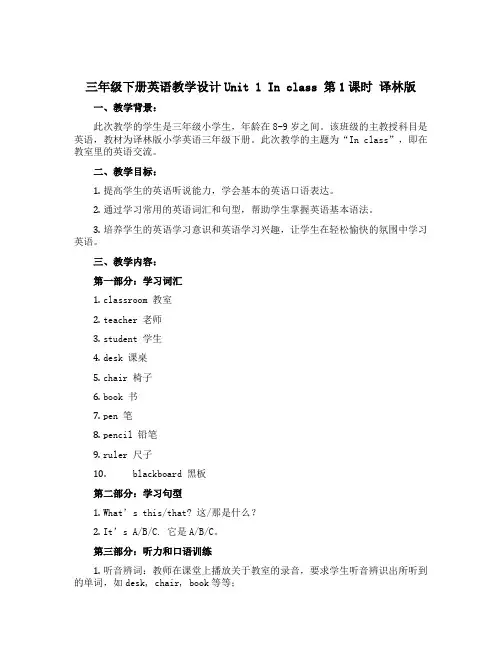
三年级下册英语教学设计Unit 1 In class 第1课时译林版一、教学背景:此次教学的学生是三年级小学生,年龄在8-9岁之间。
该班级的主教授科目是英语,教材为译林版小学英语三年级下册。
此次教学的主题为“In class”,即在教室里的英语交流。
二、教学目标:1.提高学生的英语听说能力,学会基本的英语口语表达。
2.通过学习常用的英语词汇和句型,帮助学生掌握英语基本语法。
3.培养学生的英语学习意识和英语学习兴趣,让学生在轻松愉快的氛围中学习英语。
三、教学内容:第一部分:学习词汇1.classroom 教室2.teacher 老师3.student 学生4.desk 课桌5.chair 椅子6.book 书7.pen 笔8.pencil 铅笔9.ruler 尺子10.blackboard 黑板第二部分:学习句型1.What’s this/that? 这/那是什么?2.It’s A/B/C. 它是A/B/C。
第三部分:听力和口语训练1.听音辨词:教师在课堂上播放关于教室的录音,要求学生听音辨识出所听到的单词,如desk, chair, book等等;2.口语练习:教师以询问问题为例,让学生回答,比如教师问:“What’s this?” 学生回答:“It’s a pencil。
”四、教学过程:第一步:引入新词汇教师拿出一张教室的照片,向学生介绍教室里的物品:classroom, teacher, student, desk, chair, book, pen, pencil, ruler, blackboard。
第二步:学习句型•教师以what的句型为例,向学生介绍What’s this/that的用法,及It’s A/B/C的回答方式。
•教师向学生展示一些物品,并问学生“What’s this?” 学生回答“It’s a book.”等。
第三步:听力训练•教师播放例如desk,chair等单词的录音,让学生尝试辨别。
译林版三年级英语下册全册教案
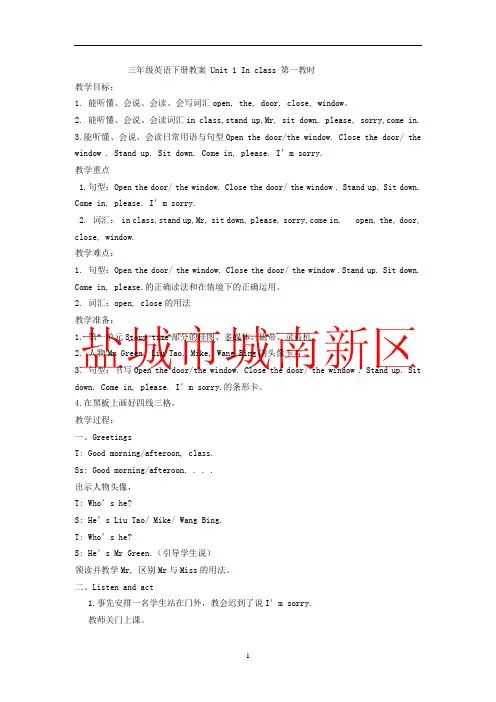
三年级英语下册教案 Unit 1 In class 第一教时教学目标:1. 能听懂、会说、会读、会写词汇open, the, door, close, window。
2. 能听懂、会说、会读词汇in class,stand up,Mr, sit down, please, sorry,come in.3.能听懂、会说、会读日常用语与句型Open the door/the window. Close the door/ the window . Stand up. Sit down. Come in, please. I’m sorry.教学重点1.句型:Open the door/ the window. Close the door/ the window . Stand up. Sit down. Come in, please. I’m sorry.2. 词汇: in class,stand up,Mr, sit down, please, sorry,come in. open, the, door, close, window.教学难点:1. 句型:Open the door/ the window. Close the door/ the window .Stand up. Sit down. Come in, please.的正确读法和在情境下的正确运用。
2. 词汇:open, close的用法教学准备:1. 第一单元Story time部分的挂图、多媒体、磁带、录音机。
2. 人物Mr Green, Liu Tao, Mike, Wang Bing的头像卡片。
3. 句型:书写Open the door/the window. Close the door/ the window . Stand up. Sit down. Come in, please. I’m sorry.的条形卡。
新版译林版三下unit1教案
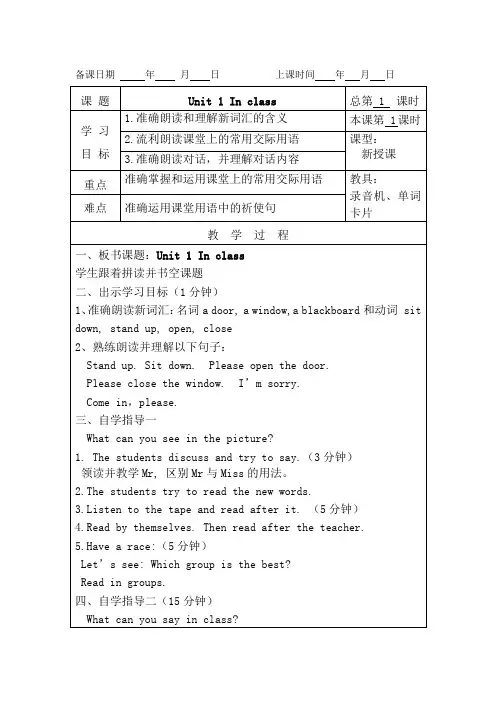
2.表演对话:6分钟
(1)自由分组扮演对话。
(2)学生到台前表演。
板书设计:
Unit1 Inclass
单词:
rubber, robot, listen, parrot
句型:
Look at the blackword.
Don’t listen to the…
Let’s see: Which group is the best?
Read in groups.
四、自学指导二(15分钟)
What can you say in class?
1.Read the dialogue freely.
2.Listen to the tape and read after it.(3分钟)
Stand up.
Sit down.
Look at the blackboard.
Please open the book.
Please close the book.
板书设计:
Unit1 Inclass
Stand up. Mr.
Sit down. Mrs.
Open the door. Miss
Close the window.
教师指令:
Simon says open the book. Stand up.
Simon says stand up. Sit down, please.
Simon says sit down, please.
Close the window, please.
Simon says look at the blackboard, please.
译林版(三起)三年级英语下册Unit1 In Class第2课时教学设计
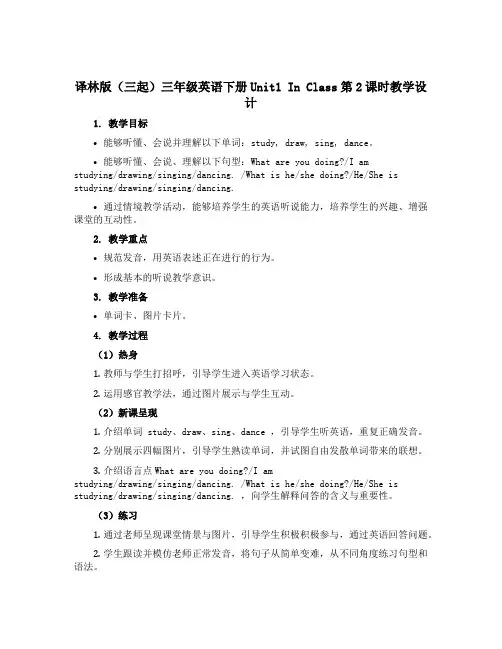
译林版(三起)三年级英语下册Unit1 In Class第2课时教学设计1. 教学目标•能够听懂、会说并理解以下单词:study, draw, sing, dance。
•能够听懂、会说、理解以下句型:What are you doing?/I amstudying/drawing/singing/dancing. /What is he/she doing?/He/She is studying/drawing/singing/dancing.•通过情境教学活动,能够培养学生的英语听说能力,培养学生的兴趣、增强课堂的互动性。
2. 教学重点•规范发音,用英语表述正在进行的行为。
•形成基本的听说教学意识。
3. 教学准备•单词卡、图片卡片。
4. 教学过程(1)热身1.教师与学生打招呼,引导学生进入英语学习状态。
2.运用感官教学法,通过图片展示与学生互动。
(2)新课呈现1.介绍单词 study、draw、sing、dance ,引导学生听英语,重复正确发音。
2.分别展示四幅图片,引导学生熟读单词,并试图自由发散单词带来的联想。
3.介绍语言点What are you doing?/I amstudying/drawing/singing/dancing. /What is he/she doing?/He/She is studying/drawing/singing/dancing. ,向学生解释问答的含义与重要性。
(3)练习1.通过老师呈现课堂情景与图片,引导学生积极积极参与,通过英语回答问题。
2.学生跟读并模仿老师正常发音,将句子从简单变难,从不同角度练习句型和语法。
(4)拓展1.教师即充当指导者的示范者,让学生跟着说部分句子。
2.希望学生在家中复习所学,和父母朋友一起用英语说自己正在进行的事。
5. 教学总结1.简短概括所学内容,肯定学生的表现与努力。
2.督促学生在课下继续练习巩固,提高英语学习的积极性。
译林版(三起)三年级英语下册Unit1 In Class第1课时教案
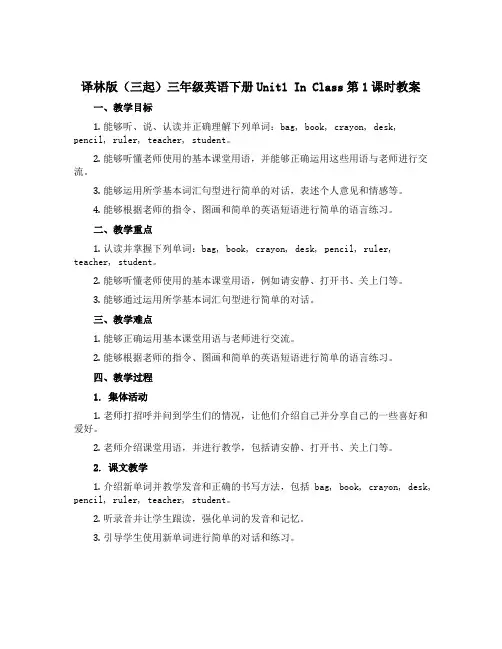
译林版(三起)三年级英语下册Unit1 In Class第1课时教案一、教学目标1.能够听、说、认读并正确理解下列单词:bag, book, crayon, desk, pencil, ruler, teacher, student。
2.能够听懂老师使用的基本课堂用语,并能够正确运用这些用语与老师进行交流。
3.能够运用所学基本词汇句型进行简单的对话,表述个人意见和情感等。
4.能够根据老师的指令、图画和简单的英语短语进行简单的语言练习。
二、教学重点1.认读并掌握下列单词:bag, book, crayon, desk, pencil, ruler, teacher, student。
2.能够听懂老师使用的基本课堂用语,例如请安静、打开书、关上门等。
3.能够通过运用所学基本词汇句型进行简单的对话。
三、教学难点1.能够正确运用基本课堂用语与老师进行交流。
2.能够根据老师的指令、图画和简单的英语短语进行简单的语言练习。
四、教学过程1. 集体活动1.老师打招呼并问到学生们的情况,让他们介绍自己并分享自己的一些喜好和爱好。
2.老师介绍课堂用语,并进行教学,包括请安静、打开书、关上门等。
2. 课文教学1.介绍新单词并教学发音和正确的书写方法,包括bag, book, crayon, desk, pencil, ruler, teacher, student。
2.听录音并让学生跟读,强化单词的发音和记忆。
3.引导学生使用新单词进行简单的对话和练习。
3. 活动设计1.设计图片模板,让学生根据老师的指令进行语言练习,例如提问学生们在哪个位置找到一个笔袋(bag),或者让学生描述一些学习用品(pencil, ruler 等)。
2.学生进行小组活动,并运用所学单词进行对话练习。
3.整合课程,进行对话练习和语言听力测试。
4. 结束1.让学生总结整节课所学的内容,并进行课堂提问,确认学生是否掌握了本课的基础知识和语言技能。
module 3 unit 1 全单元教案(译林牛津版高一英语必修三教案教学设计)

Unit 1 The world of our senses教案设计教材整体分析:1. Welcome to the unitIn this part, students are encouraged to conduct a free discussion about the importance of five senses in their studies and daily life. Students are expected to express their opinions boldly and imaginatively.2. ReadingThe reading text deals with a story about what happened to a young lady on a thick foggy afternoon. The reading strategy of this unit teaches students how to comprehend a story better while reading it. Studentswill practice identifying these elements.3. Word powerThis section has two parts. In the first part, students will learn that many words in English can have different roles in different types of sentences. In the second part, students will review and learn words used to describe different kinds of weather.4. Grammar and usageThe grammar focus in this unit is on noun clauses. Students are expected to learn what noun clauses are and understand how to use the conjunctions that and if/whether to introduce noun clauses.5. TaskThis section consists of a series of activities which will provide students with opportunities to practice the language skills. And through the three steps, students will learn how to plot a story, prepare a surprise ending and improve their language in storytelling.6. ProjectThe project in this unit is designed to help students learn and use English through doing a project. The purpose of this section is to help students use what they have learnt to finish a project by working together.7. Self-assessmentThis section aims to help students determine the progress they have made.Period 1. Welcome to the unitTeaching goals:Encourage students speak out to practice their oral English .Arose their interest in learning this unit through activities.Let them know the importance of senses in daily life.Teaching important and difficult points:Help students prepare for their discussion, making sure that they are fully prepared before the lesson.Teaching ProceduresStep1. BrainstormingAsk students the following questions:1. With what do we see and hear?2. How do we know whether a dish is delicious?3. How do we know that a flower has a pleasant smell?4. What do we do when we want to know whether the water in the basin is hot or cold?5. How do we know about the world around us?As we all know, almost everyone has five senses, which are used everywhere and all the time. We learn about the world through the five senses. We use the five senses to study, work and relax, but there are some people who have lost one or more of their senses.Step2 Presentation1.What would happen if you lost one or two of your senses?A person who cannot see is blind and someone who cannot hear is deaf..2. Do you know how blind people can read?(They can read by touching raised dots which represent numbers and letters. This system is called Braille.)3. How do the deaf communicate with each other?(They use body language or sign language.)Step3 DiscussionLook at the four pictures and answer the question below each picture.1.What can you see in this picture?2.How would you judge the length of the two lines?3.How can you prove that the two lines are straight?4.Can the symbols be read in only one way?5.Why are people misled by their own eyes?Step4 Language studyFill in the blanks with words that have something to do with “senses”:When he got there, he _________ that there was a dark hole. He ________ into it, but could ________ nothing. He ________ with his ears, he could _______ nothing, either. He _________ it for a long time. He _______ something strange. He ___________ the side of the hole. It ______ hot. Suddenly some noises were ________ from the hole. It ________ like someone was cooking inside.Step5 Discussion1. Read the three questions in the short passage and discuss them in groups of four.2. Report your answers to the whole class.Step6 Assignments1. Preview the reading part, do exercise C1 and C22. Preview the reading strategyPeriod 2 ReadingTeaching goals:Improve Ss’ reading ability.Enable Ss to master some important language points.Make sure Ss can learn to help each other in their daily life.Teaching important and difficult points:Master the use of some language points.( wish for; reach out ; watch out for; pay back…)Retell a story with a surprise ending.Teaching proceduresStep1: Lead-inAsk students to talk about the climate or the weather in the place where they live:What’s the weather usually like in spring in Liyang?Which season do you think is the best? Why?Do we sometime have foggy days here? When?How do you feel on a foggy day?Have you ever lost your way in the fog? What would you do if you gotlost in the fog?Which city has the name of “foggy city”?Step2: Reading1. Ask students to go through the passage as quickly as they can and try to find answers to the four questions in part A.2. Ask students to read the passage again and complete partsC1and C2.3. Ask students to fill in the blanks according to the text.Step 3: ListeningListening to the text and read together with it.Step 4: Reading strategy1. Guide students to read the Reading strategy for the article and teach them the elements of a story.2. Give students another story to read and practice identifying the essential elements of a story.Step 5: PracticeAsk students to complete Parts D and E.Step 6: Assignments1. Finish A1 and A2 on page 90 of the Workbook.2. Retell the story in their own words.3. Find out the difficult points in the passage.Period 3 Language studyTeaching goals:Help students understand fully of the text.Deal with some difficult sentences and useful language pointsTeaching important and difficult points:mastering the use of some of language points: in sight, wish for, reach out, watch out for, pay back, be frozen with, be related to, be linked to, make sense, make the most of, can’t help doing,Teaching proceduresStep1 RevisionRetell the story:Help the students retell the story Fog in their own words. Use the chart to help them:Outside Polly’s working place-----at the bus stop on the street------in the Underground train-----at Green Park station------- in ParkStreet------- at the corner of the street----- in the street near King Street------ at 86 King StreetStep2 Difficult sentencesRead and understand the following sentences, then remember in mind:1. Once out in the street, she walked quickly towards her usual bus stop.2. ‘Sorry, Miss,’ replied the man, ‘the truth is that the fogs too thick for the bus to run that far.3. While the rest of the passengers were getting out, she glanced at the faces around her.4. The tall man was nowhere to be seen.5. As she walked along, she heard the sound of footsteps, but by thetime she reached the corner of the street, the footsteps were gone.6. Polly found herself staring up at a man standing with his handresting on her arm.Step3 Useful words and phrasesStep 4 AssignmentFinish the learning plan.Period 4 Word powerTeaching goals:Make sure students can know the different roles some words can have in different types of sentences.Enable Ss to master the meanings of some words used to describedifferent kinds of weather.Teaching important and difficult points:Train Ss to guess and understand the meanings of the words according to the context and pictures.Teaching proceduresStep 1 RevisionCheck the homework assigned the day before.Step2 BrainstormingStep 2. Brain stormingWrite down two sentences on the blackboard:Once out in the street, she walked quickly towards her usual bus stop.“Here we are, King Street.” He stopped.Which word has two meanings and two parts of speech?How many other words which have more than one part of speech can you think of?Step 3. Parts of speech1. Ask students to read the speech bubbles on page 6. Make sure that they pay attention to the word rest and get them to describe thef=different meanings of it in different parts of speech. Then have them read the instructions for Part A.2. Ask students first to complete the table in Part A individually and then to discuss in pairs the answers. Encourage students to make different sentence.. Then check the answers with the whole class.Step 4. PracticeAsk students to complete part B according to the instructions. Then have one or two of them read the short report.Step5. Describing the weather1.Ask students what words they use to describe different kinds of weather. Write down on the blackboard the word students say.2. Ask students to practice reading in pairs the dialogue in Part A. They may look at the symbols in Part B for reference.3. Have students first look at the symbols for different kinds of weather and then let them read the weather report in the first speech bubble.4. Ask students to complete the second speech bubble by looking at the three pictures below it.Step6. Assignments1. Finish the learning plan exercise2. Review the grammar and usage--- noun clauses.Period 5-6 Grammar and usageTeaching goals:Make sure the students understand what the noun clauses are.Ss should know the different use of noun clauses.Learn to use conjunctions that, if/whether.Teaching important and difficult points:Noun clauses can be used as different parts in a sentence.The use of that in subject clause and the different use of if and whether.Teaching procedures:Step1. Introduction to noun clausesWhat is noun?What is the use of noun?What is noun clause?(by reading some sentences):1.When we will start is not clear.2.Mrs Black won’t believe that her son has become a thief.3. My idea is that we should do it right now.4.I had no idea that you were her friend.Step2. Presentation1. Ask students to read Part 1 on page8 so that they will know that a noun clause can be used as the subject of a sentence. More sentences can be given to the students.1) That he will succeed is certain .2) Whether he will go there is not known .3) What he said is not true .4) Where he hid the money is to be found out .Have students read the sentence in which it is used as an empty subject:Who will go makes no difference.= It makes no difference who will go.That she was able to come made us very happy.=It made us happy that she was able to come.2. Ask students to read Parts 2 so that they will know that a noun clause can be used either as the object of a verb or a preposition in a sentence.1) They know that the habit will kill them.2) He asked how much I paid for the violin.3) He made it clear to the public that he did an important and necessary job .4).I find it necessary that we should do the homework.Ask students to read the two sentences in which it is used as an empty object.3. Ask students to read Part 3 so that they will know that a noun clause can be used as the predicative after the link verb be.1)The question is whether we can rely on him.2)That’s because we were in need of money at that time .3)He looked as if he was going to cry .4)That’s why I was late4.Explain to students what apposition means. Then have the students read Part 4.Step3 PracticeAsk the students to read the article on page 9 and to describe the main idea in their own words. Make sure that they know what they need to do and that they can identify all the noun clauses.Step4 PresentationNoun clauses beginning with that or if/whether1.Ask the students to read Part 1, which is about using that to introduce a noun clause.2. Have students read Part 2, which is about using if or whether to introduce a noun clause.When do we use if/whether to introduce a noun clause?When can we only use whether bet not it?Step5 PracticeAsk students to finish exercises on page11.Step6 Assignment1. Finish the exercises in learning plan.2. Finish C2 on page 92 of the workbook.Period7---8 Task: Telling a storyTeaching goals:Make Ss know the sequence of a story.Train Ss’ ability of telling a story effectively by using pictures with speech bubbles.Improve Ss’ ability of writing a story by using adjectives and adverbs.Teaching important and difficult points:Make sure Ss know the importance of adjectives and adverbs in the story.Enable Ss to write a story correctly.Teaching proceduresStep 1 Revision1. Check homework.2. Do some exercises to revise the noun clauses.Step 2 Skills building 1: Plotting a story1. Ask students to read part A on page 13. They need to know what they have been asked to do and what information they should get whenlistening to the tape. Have them complete the checklist individually, and then ask them to check their answers with their partners to see if they have the same answers. The class can listen to the recording again if necessary.2. Ask students to listen to the conversation and answer the questionsin Part B. After they finish this part, let them check their answers with their partners to make sure that they have got the correct answers.3. Tell students that they will write the beginning of the story using their answers in Part B.Skills building 2: identifying different elements of a comic stripStep3: preparing a story with a surprise ending1. Ask students to read the guidelines on page 15 and make sure that they know what they need to do. Ask them to first work individually andthen to check their answers with their partners. If they have different answers, have them discuss which answer is better.2. In pairs, ask students to work out a surprise ending from the five pictures given in Part A. They should draw a picture, write a caption and add thought, speech or sound bubbles where necessary. Encourage students to use their imagination and create any ending which is surprising. Choose some students’ pictures and show them to the whole class. Ask students to decide which is the best picture with a surprise ending.Skills building 3: using adjectives and adverbs in stories.Step 4: improving your story1. Have students read the guidelines in Part A on page 17. Ask them to go over the adjectives and adverbs given in the box. Guide them to point out which words are adjectives and which are adverbs. Ask them to first fill in the blanks with the words in the box, and then write the last paragraph of the story using the sixth picture they drew in Step2.2. Ask students to think about what good storytellers will do to make others interested and willing to listen to them. Ask students to read the guidelines in Part B. Have them work in pairs to practise telling the story they have just finished. Then ask some students to present their stories in class. The whole class should decide who is the best storyteller.Ask students to read the story of Part A in Writing on page 97 of the Workbook, and then finish Part B. They can do Part B as homework.Step5 Homework1. Ask Ss to write a story.2. Find out the difficult points in Project.Period 9 Project: Producing a TV showTeaching goals:Do some reading.Improve Ss’ ability of writing.Get Ss to cooperate with others.Teaching important and difficult points:Know the general idea of the passage.Make sure Ss know how to write an interesting story.Teaching proceduresStep1 Reading1. Ask students to read the article Shark attacks and find out as much information as they can about sharks.2. Have students read the article again and ask them to find out what unique senses sharks have, what senses sharks use to attack humans and what people can do to protect themselves.3. Ask students to do Part B1 and B2 on page 91 of the Workbook eitherin class or as homework, so they will have a better understanding of the usage of words and phrases learnt in this section.4. Ask students to do Parts D1 and D2 on page 93 of the Workbook as homework to review the useful words, phrases and patterns they have learnt in this unit.Ask students to do the listening exercises in Part A and B on page 96 of the Workbook to learn more about animals’ senses.Step 2 Language pointsI. Deal with some language points for Ss to understand the letters better.II. If Ss still have questions, help to solve them.Step3 Producing a TV showPlanningAsk students to work in groups of four. First ask them to discuss and choose which animal they would like to focus on. Have them write down the animal’s name and one of its unique senses. As some students may keep pets at home, they will be quite familiar with some pet animalssuch as dogs, cats or fish. They can choose one of the animals that they are most familiar with. Students should also choose what type of show they will produce. Each group member will be responsible for researching information about one aspect of the animal.PreparingStudents will go to a zoo, watch an animal documentary, read some books or surf the Internet to get the information they need. While they are doing such things, they need to take notes. They will get together to discuss what should be included in their show. They will make a list which focuses on how the animal uses its senses and think about how to present the information.ProducingStudents each work on a different part of the TV show. When thedifferent parts are put together, each group member should read the writing carefully, correct the mistakes and add some new ideas.PresentingEach group will take turns presenting their TV show to the class by showing their work and narrating. Students can have a discussion to decide which group’s TV show is the best.Step 4 Assignment1.Finish the learning plan2. Prepare for a test.Period 10 Self-assessmentTeaching goals:This part at the end of the unit aims to allow students to determinewhat they have achieved and what else they can do to improve their study.Teaching procedures:1. Do a review test to consolidate what Ss have learned in this unit.2. Let Ss do the self-assessment. Know the situations and help those Ss who have trouble.。
三年级英语下册 Unit 1 In class(第三课时)教案 牛津译林版
What’s the date today?
What’s the weather like today?
What can you do?
What do you like?
Step2. Revision
1.Read and spell the words and phrases
Dictate the ten sentences.
拓 展 延 伸
板 书设 计
Unit1 Inclass
Open your book and say “Hello!”
Close your book and off we go!
Please…..= …., please.
课后反 思
(本资料素材和资料部分来自网络,供参考。请预览后才下载,期待您的好评与关注!)
2.Put the sentences into the right order
Step3 Presentation
1.Rhyme time
a. Watch the video and mark the differences:thewindow,thedoor,yourbook
b. Make up a new rhyme: Students can use “ pencil-box, schoolbag…”.
学习难点
The rhyme: Open your book and say “Hello!”. Close you book and off we go!
教学准备
PPT
学生
预习
内容
教 学 流 程
Step1 Warming-up
1.Greetings.
Unit 1 In class 第一课时(教案)译林版(三起)英语三年级下册
Unit 1 In class 第一课时(教案)译林版(三起)英语三年级下册一、教学目标1.学会问候与介绍。
2.能够正确读出本单元所有单词和句子。
3.能够熟练运用所学知识进行对话。
二、教学重点1.学会使用单词和句子进行交流。
2.了解日常问候和介绍。
三、教学难点1.能够掌握所学知识,并在实际对话中运用。
2.能够理解并回答听到的问候和介绍。
四、教学过程1. 导入新知识1.教师通过幻灯片介绍本单元学习内容,并安排各种语言交际活动,引导学生学习英语。
2.通过展示图片和视频,让学生了解身边的事物、场景和人物,并鼓励他们描述这些事情。
2. 新课讲解1.介绍问候语和介绍的常用表达方式,并运用日常场景进行教学。
2.教师带领学生读单词、短语和句子,让学生模仿发音和表达。
3.讲解中国人的姓和名的习惯,并让学生了解其他国家的命名法则。
3. 听力练习1.教室里播放几个有关问候和介绍的录音,并让学生听一遍。
2.配置练习题,让学生听多次录音,理解然后回答问题。
4. 阅读练习1.让学生阅读课本里有关问候和介绍的篇章,理解课文的意思,掌握其中重要内容。
2.安排相关词语和句子的练习,让学生加深印象,提高阅读水平。
5. 讨论和互动练习1.发送一个相关主题的问题,并让学生分享自己的看法和经验,增强互动学习的效果。
2.安排专题小组活动,让学生互相帮助和学习。
学生用所学语言进行交流运用,加深印象并提高语言表达能力。
6. 语法和拼写练习1.通过练习题安排语法和拼写练习,鼓励学生升华所学知识。
2.让学生在压力下进行练习,增强其对所学知识的掌握和应用能力。
五、课堂总结1.教师对所学知识进行整理,让学生逐渐理解和掌握。
2.教师布置作业,并提醒学生随时复习所学知识。
六、教学评价1.评估学生在课堂上的表现,并针对其在语言表达能力、语法和拼写能力方面的不足进行指导。
2.帮助学生克服学习困难和挫败感,激励他们继续学习。
译林版高中英语选必三Unit1 Integrated skills 教案(雅礼版)
Unit 1 Wish you were hereIntegrated skills: Making a travel plan for foreign guests◆内容分析:本板块围绕单元话题,以“为外宾制订旅游计划”创设情境,展开一系列具有综合性、关联性和实践性的听、说、读、写等学习活动。
教学活动首先引导学生听一段介绍外宾来访的音频,获取相关信息;再让学生阅读一份上海旅游计划,学习如何规划旅游行程;最后让学生就如何为到访家乡的外宾制订旅游计划展开讨论,以邮件的形式告知外宾相关安排。
上述活动环环相扣,每个活动既有侧重点,又与其他活动有关联性,构成一个语言技能整合的活动。
◆教学目标:By the end of this section, students will be able to:1. learn about what is included in a travel plan;2. grasp the features of the travel plan;3. arrange a two-day visit to their hometown;4. write an email to inform foreign guests of the travel plan;5. improve their cross-culture communicative competence.◆教学重难点:1. Grasp the features of the travel plan;2. Writing an email about the travel plan.◆教学过程:Step 1 Lead-inAsk students the question:1. Where would you go to spend your winter vacation?2. Do you have a travel plan?3. What might be considered while making a travel plan?A. Destination.B. Starting and ending date.C. Transportation....【设计意图:快速引入单元话题。
三年级下册英语教学设计-Unit 1 In Class 课时3|译林版(三起)
三年级下册英语教学设计-Unit 1 In Class 课时3|译林版(三起)教学目标1.能听、说、读、写单词和句型:What’s in the box? Is it a pencil/pen?2.能听懂并会运用句型:What’s in the box? Is it a pencil/pen? 进行简单的对话。
3.培养学生的语言表达能力和合作能力,激发学生的英语学习兴趣。
教学重难点1.学生能听懂并运用句型:What’s in the box? Is it a pencil/pen? 进行简单的对话。
2.学生能正确区分单词 pen 和 pencil。
教学准备教师准备:教学PPT,flashcard学生准备:学生书,练习册教学过程Step 1. 导入新课1.教师问学生们课堂里有什么东西,学生们回答“desk, chair, book, pencil”等。
教师再问“box”,学生们会回答“box”。
2.教师拿出一只盒子,问学生们盒子里有什么。
学生们回答不知道。
3.教师提示学生:“What’s in the box?”4.学生齐声回答:“What’s in the box?”Step 2. 学习新词1.展示 flashcard,教师大声读出“pen”和“pencil”。
2.教师提问:“What’s this?”。
3.学生齐声回答:“pen/pencil”。
4.教师清晰地说出两个单词以帮助学生区分。
Step 3. 学习新句型1.展示 flashcard,教师大声读出“What’s in the box? Is it apencil/pen?”。
2.教师模仿上面的句子问一个学生。
3.学生回答:“Is it a pencil/pen?”。
4.组织学生进行两人一组的练习,鼓励他们进行问答练习。
Step 4. 拓展练习1.要求学生根据图片描述物品,如:“What’s this? It’s a book。
”2.让学生以小组形式完成活动本上的练习。
- 1、下载文档前请自行甄别文档内容的完整性,平台不提供额外的编辑、内容补充、找答案等附加服务。
- 2、"仅部分预览"的文档,不可在线预览部分如存在完整性等问题,可反馈申请退款(可完整预览的文档不适用该条件!)。
- 3、如文档侵犯您的权益,请联系客服反馈,我们会尽快为您处理(人工客服工作时间:9:00-18:30)。
(板书:open/ close the door
open/ close your book(S)
open/close the window
look at the … )
Step 2 Cartoon time & Ticking Time
T: How do you know?
S1: Don’t listen to the parrot, Sam!
T: Great! (PPT) Don’t listen to the parrot, Sam! Don’t =Do not
(领读这句话3遍)
T: Why? Why don’t listen to the parrot? You can speak in Chinese.
1.Lead in.
(由刚才的小诗,学习单词bird. b, b, b, — b, b, b, — bird)
T: This bird is the parrot.( PPT)(学习单词parrot.æ æ æ,parrot)
2. Read and choose.
T: This parrot and Sam are in class now, Bobby is teaching them. How is Bobby ? Is he angry?(PPT)Please open your books at page 9. Read the story by yourselves . (学生自由朗读课文)
教学
资源
多媒体课件
学程预设
二次调整
Step 1 Warm up
1.Greetings.
2. Show Learning goals.
T: Boys and girls, we are in class now, so let’s look at the Learning goals.(PPT)
3. Let’s play.
T: Are you ready? Let’s go!
师先转,一个学生说指令,其余学生回答。接着让学生来转,
( S—S, B—G, Group—Group, S—Ss)
(Tips:×××,please… .=Please…,×××.如:Liu Tao, please stand up .=Please stand up, Liu Tao.)
4. Look and write.
T: Let’s check. (PPT)(请3位同学板书)
(学生做好后,同桌互换。)
5. Ticking time
T: How many stars can you get for No.5?
Step 4 Do exercise & Ticking Time
1.Do exercise.
7.Ticking time.
T: Now it’s time for ticking. (PPT) For No.1 and No.2, how many stars can you get? (同桌互评)
T: Great! Do you want to get more stars?
Ss: …
Step 3 Checkout time & Ticking Time
2. Ticking time
T: Ok, how many stars can you get for No.3 and No.4?
3. Good memory.
T: You can say now, can you write? (PPT) Look, who has a good memory? 2 minutes! Remember the words quickly! (学生记忆单词)
ys and girls, (PPT) choose one picture you like to read. (每幅图至少让4个同学来表达) Who can be better?
6. Read in roles.
T: You all did a good job. Now let’s read in roles.(PPT) Girls act as Bobby, Boys act as Sam, and Miss Du act as the parrot. Ok, are you ready? let’s go!
T: First, let’s play a game. When you see a instruction , please say it out loudly, when you see a bomb, please say “bomb”.(PPT)
4. Say and complete.
T: They make a rhyme, let’s complete it. (PPT)
S2: ……
T: Boys and girls, Sam doesn’t look at the blackboard, and doesn’t listen to Bobby in class. Yes?
Ss: …
3. Watch and read.
T: It’s interesting. Do you want to watch the cartoon?....
教学
内容
3下Unit1 In class
Cartoontime
共几课时
5
课
型
新授
主备人
城南新区伍佑小学
第几课时
3
王静
学习
目标
1.能听懂、会说、会读、会运用单词:robot/ rubber/ parrot.
2.能听懂、会说、会读、会运用句型:Look at the…/ Don’t…
3.能快速用It’s a…来回答What’s this?的提问。
T: Ok, let’s follow it, and find out the words you can’t read.
(PPT)(学生观看并跟读)
(Robot rubber的发音)
4. Read in pairs.
T: Now it’s your turn, please read in pairs.(PPT)
4.能用Don’t…来造句。
教学重难
点
教学重点
1.能听懂、会说、会读、会运用单词:robot/ rubber/ parrot.
2.能听懂、会说、会读、会运用句型:Look at the…/ Don’t…
教学难点
1.能快速用It’s a…来回答What’s this?的提问。
2.能用Don’t…来造句。
But if you can’t, it doesn’t matter, please come on!
教学反思:
1. Look and say.
T: Now let’s play a game.(PPT) Turntable—Rules: …
But before do it, don’t forget “ please” ,出示小贴士( Tips:礼貌用语Please别忘记吆!Please… .=…,please.)并板书。
T: Look, here’s more exercise for you.(PPT)(4.师教生动作:listen, listen, listen,—look, look, look.)
2.Ticking time
T: If you can get 3 stars of each of the learning goal , Congratulations!
